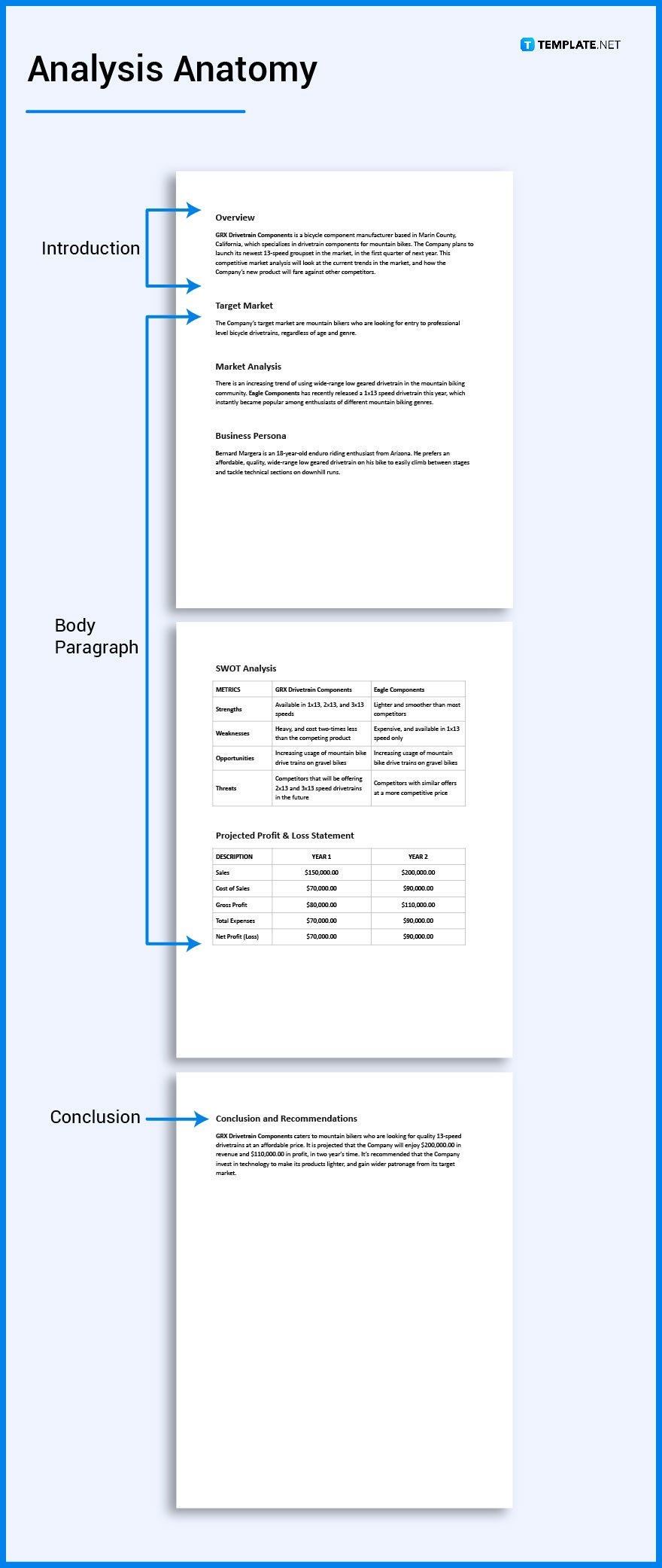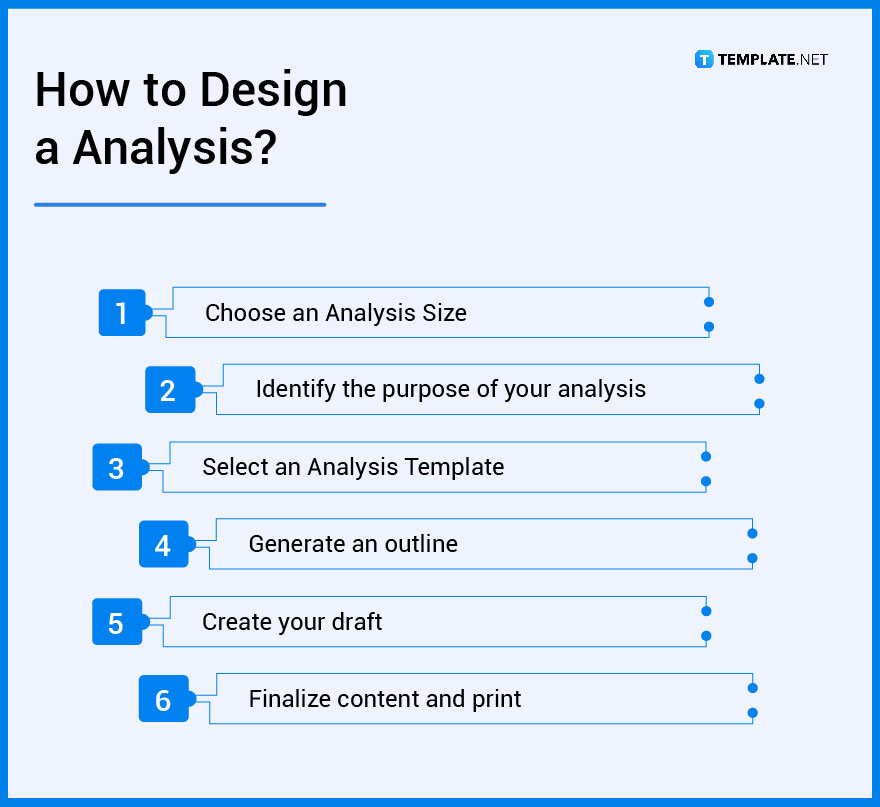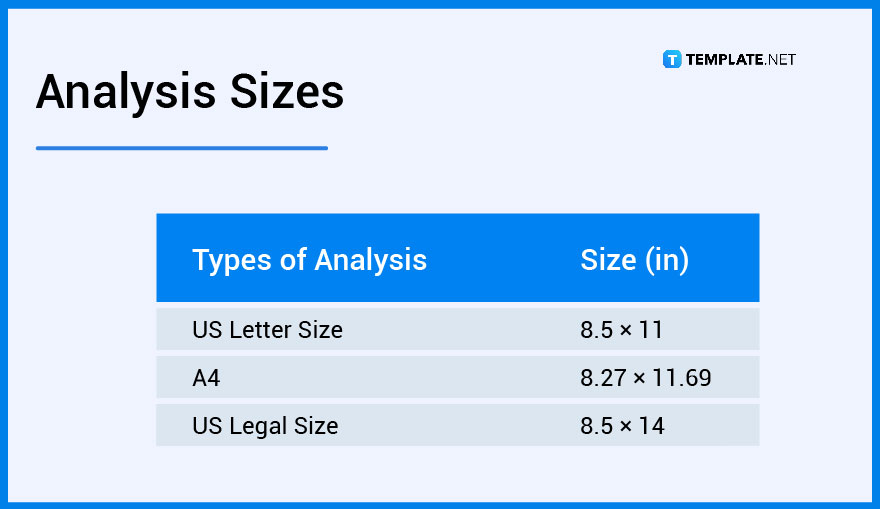![How To Create Meeting Minutes in Google Docs [Template + Example]](https://images.template.net/wp-content/uploads/2023/07/How-To-Make_Create-Meeting-Minutes-in-Google-Docs-Template-Example-788x443.png)
How To Create Meeting Minutes in Google Docs [Template + Example]
Meeting minutes Play a vital role in the recording of meeting information and details. In any kind of meeting, there is always…
Feb 12, 2025
Analysis helps with determining areas for improvement and drives a culture for making data-driven strategies and decisions. In varying industries, generating analysis is a crucial step to improving operations and securing better opportunities.

An analysis is a process of breaking down complicated concepts and organizing them into bite-sized ideas to simplify the process of understanding them.
This means that with an analysis document, you can gain better insights into a topic or structure and solve existing or anticipated problems.
An analysis is a process of gathering basic information and necessary facts to make informed interpretations of a topic. The goal of creating an analysis is to discover something, provide solutions, or express judgment. Furthermore, it involves illustrating or presenting ideas and generating conclusions.
When you perform a cost analysis, you should study a cost summary and generate reports for its elements. It exposes hidden costs and brings factors you missed into the light. Also, you can have an idea and anticipate cost behavior concerning varying business activities.
Construction analysis concerns the moving parts and the resources involved throughout the construction project. It involves careful planning while considering existing data and analyzing results. For this process, you should study equipment, and materials, resolve issues, improve safety management, and have an extensive list of other tasks.
Competitor analysis refers to gathering information regarding existing competitors with similar services and products. With this type of analysis, you can measure your performance in the competitive landscape and identify direct and indirect competitors. It helps you anchor your direction and find working strategies when making needed changes in your business processes.
Business analysis helps identify areas that need improvement and resolve issues. With this, you can ensure that you have a clear view and understanding of business elements, their dependency, and results. It improves operational efficiency and financial management, mitigates risks, and establishes trust with essential stakeholders.
Whatever industry you belong to, studying your market is a must to ensure you can develop targeted operations and strategies to deliver the right impact to both prospects and your existing customer base. When composing your market analysis document, you can use graphs and other visual elements to determine the patterns and interrelationships of the gathered data. Additionally, it aids in recognizing quantitative and qualitative factors that might affect your market.
Project analysis is the examination of the varying project aspects. When generating a project analysis document, you should review project costs, timeline, tasks, and other essential factors. It ensures that you can undergo the varying phases while aligning your processes with your project goals.
When undergoing projects or delegating tasks to employees or teams, running an in-depth work analysis would help your efficiency. Doing so will help you get the right people with the technical skills that best suit specific tasks. Work analysis clarifies your priorities and gives you a clear view of how an activity or job affects or contributes to the overall operations.
The research analysis process involves evaluating quantitative and qualitative data and applying statistical or logical methods to interpret and present ideas. Planning and investigation are crucial elements of this research practice. One of its goals is to unravel the complexities of collected interview and survey data from samples by restructuring and organizing them.
When developing employee training programs, administering a training analysis would ensure that you get to personalize the learning experience of your trainees to amplify its results. It involves identifying gaps in your current training processes to the current training needs. With this practice, you can address concerns and customize learning paths and courses to achieve your desired results.
One method to measure your business performance and compare it with your targeted performance is through gap analysis. With this in-depth analysis, you can pinpoint differences and operational pain points. The results of your gap analysis will help you pivot your plans and strategies and respond to issues competently.
Taking a step without understanding the reason and outcomes for the action would not get you closer to your goals. That said, learning how to analyze data and articulating them on paper is an essential skill. Read on and learn more about the other uses of analysis.
Analysis helps you get familiar with topics, clarifies how things work, and further explains outcomes. That said, it equips you with the data you need to tackle situations and enhance processes using steps that work.
When you decide on something, it can be a make or break factor that can affect overall results. That said, through data analysis, you can ensure you have the necessary data and knowledge within reach to anticipate possible outcomes and make informed decisions.
The best way to solve a problem is by tracing its root cause and nipping it in the bud. The process can be complicated and taxing, but undergoing analysis would make you a more effective problem-solver.
Analyzing essential details of a project and understanding its components will help you decide on the most efficient and productive approach to resource planning. It streamlines time management and engages your human resources to establish harmony and boost motivation in your workforce.
Doing the right thing at the perfect timing creates new opportunities for you and puts a seal on existing ones. That said, when you pursue continuous improvement through analyzing data and careful observation, it boosts growth and improves the experience.
When writing an analysis document, you start off by giving an introduction or brief details regarding what you want to discuss in your analysis. This is where you write your purpose for the paper and your thesis statement to engage and hook your audience.
You can have several body paragraphs to discuss your claims and assumptions and provide evidence to support them. In this component, you will detail your analysis and mention their significance.
The conclusion is the summary of the points discussed. It is also the part of the analysis where you will include the relevance to a broader context and specify plans and studies that are relevant.

1. Choose an Analysis Size
2. Identify the purpose of your analysis
3. Select an Analysis Template
4. Generate an outline
5. Create your draft
6. Finalize content and print

An analysis is a document that provides an in-depth discussion of a concept or structure and requires you to state an argument, interpretation, opinion, evidence, or conclusion on the reliability of data and its relevance and effectiveness.
A summary is a document you write to discuss topics or ideas based on the author’s perspective and state the main points using your own definition.
Analysis papers give you the reason and explanation regarding changes and outcomes for better responses and smarter decisions.
A report gives you the necessary information to keep you up to date with the happenings.
An evaluation involves following specific criteria to measure performance and track the effectiveness of addressing needs and meeting objectives.
In the US and Canada, people mostly use the standard analysis size of 8.5 inches by 11 inches, and for documents with longer content, they choose the sheet size that measures 8.5 inches by 14 inches. While in the UK and other countries, using paper with dimensions of 8.27 inches by 11.69 inches for their documents comes naturally.

People with varying professions and those that belong in varying industries will have to write analysis papers more than once in their lives. That said, here are analysis ideas and examples you can look into to guide you through the process of writing your paper or document and free you from your block.
Analysis of a project is the practice of reviewing the varying project elements and resources to create a strategy to ensure the project adheres to the budget and deadlines while producing the best results.
When asked to write an analysis for a literary work, essay, book, process, or art, you should conduct intensive research and critical analysis to ensure you can supply the accurate and appropriate context and information in the introduction, body paragraphs, and conclusion of your paper.
A business analysis pinpoints inconsistencies and inefficiencies in your processes and helps you develop effective responses and solutions for business growth.
SWOT analysis is a strategic method of using texts and diagrams to determine the strengths and weaknesses of your operations and identify existing and possible opportunities and threats.
Writing an outline for your analysis to guide you through the writing process will help you skillfully structure and organize the ideas in your analysis.
Root cause analysis, as its name states, is identifying the root cause of identified problems or cases for efficient problem solving and making necessary adjustments or changes in the system.
Situational analysis is one method in strategic management for studying internal and external factors that can affect business processes and the environment.
Content analysis refers to the research tool for analyzing patterns, relationships, and meanings in a text, image, video, and other recorded human artifacts.
Regression analysis uses statistics and a mathematical formula to measure the importance of variables and determine their impact on each other.
Correlation analysis allows you to spot relationships and make connections of variables to enhance business insights and make informed predictions.
The types of data analysis can vary depending on your purpose for writing your analysis and the method you decide to use to draw conclusions, these types include causal analysis, predictive analysis, descriptive analysis, mechanistic analysis, and inferential analysis.
What are the five methods for analyzing qualitative data? When writing qualitative research, you can use plenty of methods to identify and understand the themes and patterns from your gathered data, such as discourse analysis, framework analysis, grounded theory, content analysis, and narrative analysis.
![How To Create Meeting Minutes in Google Docs [Template + Example]](https://images.template.net/wp-content/uploads/2023/07/How-To-Make_Create-Meeting-Minutes-in-Google-Docs-Template-Example-788x443.png)
Meeting minutes Play a vital role in the recording of meeting information and details. In any kind of meeting, there is always…
![How To Make/Create a Manual in Google Docs [Templates + Examples] 2023](https://images.template.net/wp-content/uploads/2023/07/How-To-Make-Create-a-Manual-in-Google-Docs-788x443.png)
Manuals are essential instructional and reference guides. They help direct and inform an individual’s actions and also explain how to…
![How To Make/Create a Manual in Microsoft Word [Templates + Examples] 2023](https://images.template.net/wp-content/uploads/2023/07/How-To-Make-Create-a-Manual-in-Microsoft-Word-788x443.png)
Creating a manual can be a time-consuming and tedious task. However, manuals and other reference guides are necessary for organizations…
![How To Create a Legal Document in Google Docs [Template + Example]](https://images.template.net/wp-content/uploads/2023/07/How-To-Make_Create-a-Legal-Document-in-Google-Docs-Template-Example-2023-788x443.png)
When creating a legal document, there are a lot of things a person has to consider, and one of which is the…
![How To Make/Create a Contract in Microsoft Word [Template + Example] 2023](https://images.template.net/wp-content/uploads/2023/07/How-To-Make_Create-a-Contract-in-Microsoft-Word-Template-Example-2023-1-788x443.png)
Contracts can come in different forms and for different reasons but the most common thing is that when a company does business with…
![How To Create a Contract in Google Docs [Template + Example]](https://images.template.net/wp-content/uploads/2023/07/How-To-Make_Create-a-Contract-in-Google-Docs-Template-Example-2023-Step-788x443.png)
Contracts are an important part of any company or business, especially those that work with different companies or businesses. Companies…
![How To Make/Create a Report in Google Docs [Templates + Examples] 2023](https://images.template.net/wp-content/uploads/2023/07/How-To-Create-a-Report-in-Microsoft-Word-788x443.png)
A report is a comprehensive document that covers a wide array of topics from finance, research, incidents, feasibility studies, and…
![How To Make/Create a Report in Microsoft Word [Templates + Examples] 2023](https://images.template.net/wp-content/uploads/2023/07/How-To-Make_Create-a-Report-in-Microsoft-Word-Templates-Examples-20232-788x443.png)
A report is a document that contains information, data, analysis, finding, and other relevant information based on a specific topic.…
![How to Make/Create a Notebook in Google Docs [Templates + Examples] 2023](https://images.template.net/wp-content/uploads/2023/07/How-to-Make_Create-a-Notebook-in-Google-Docs-Templates-Examples-2023-788x443.png)
Notebooks always come in handy in writing important information or expressing our thoughts through written words. When we need a…